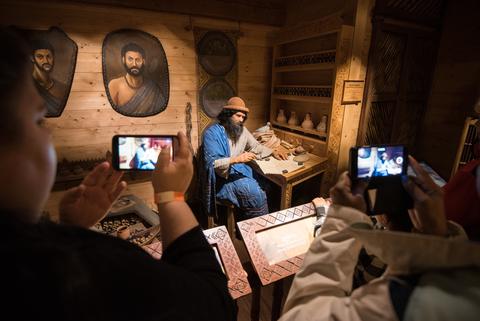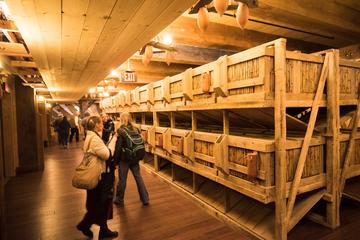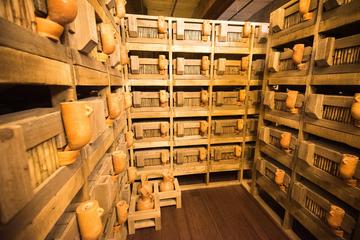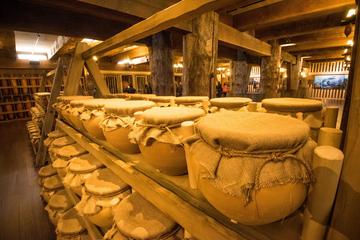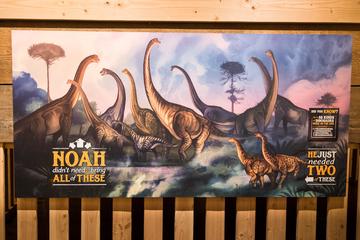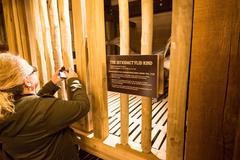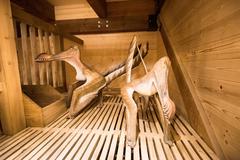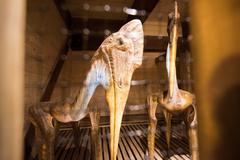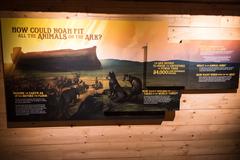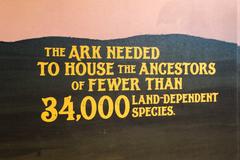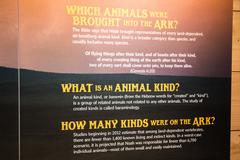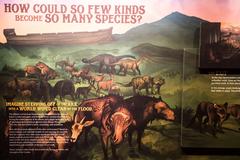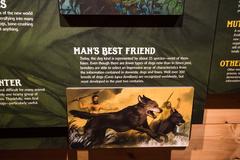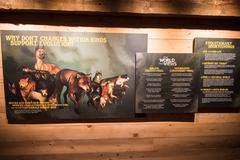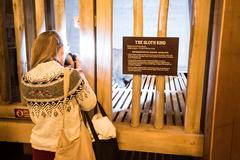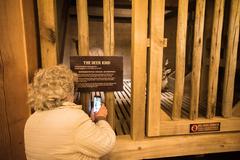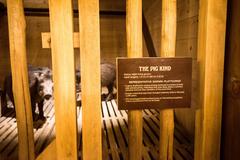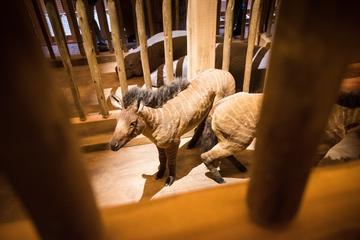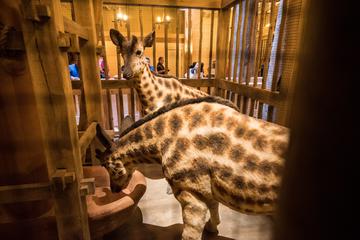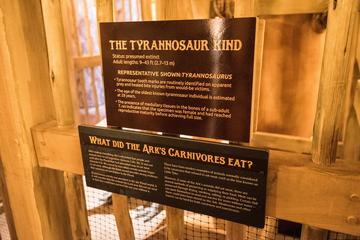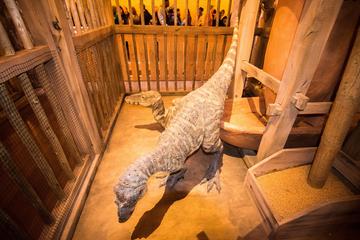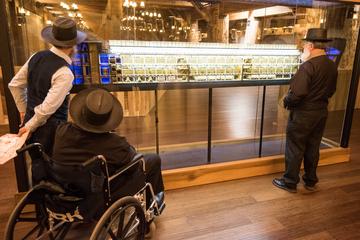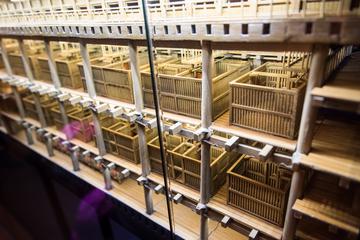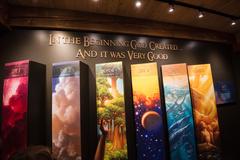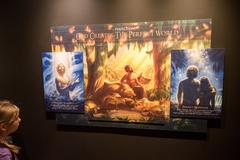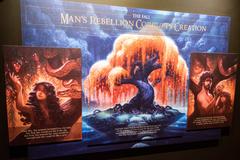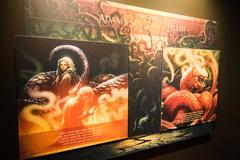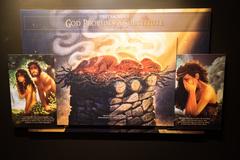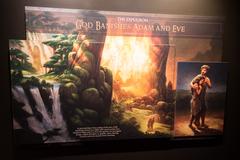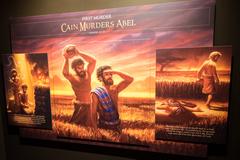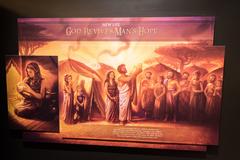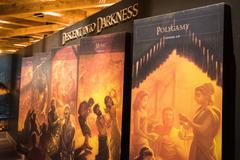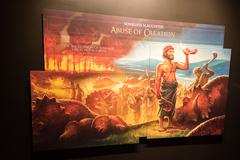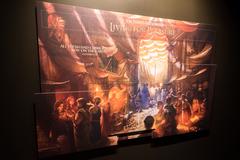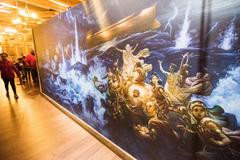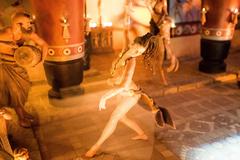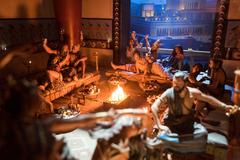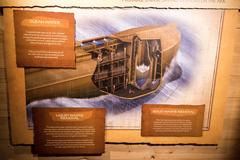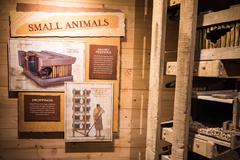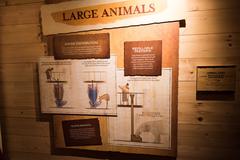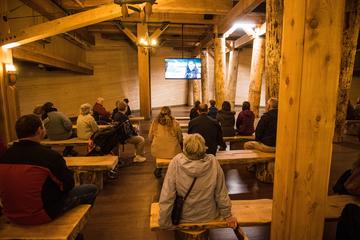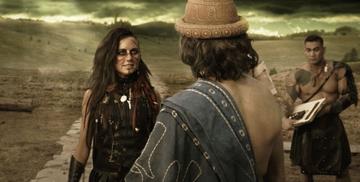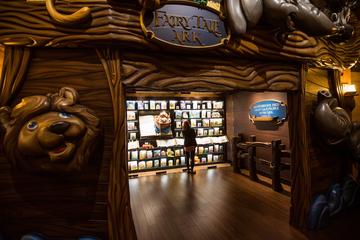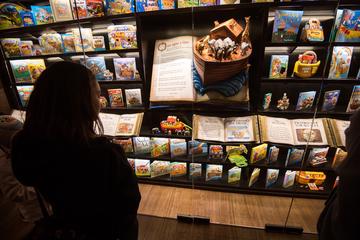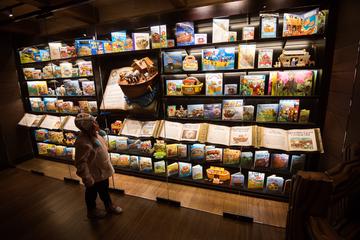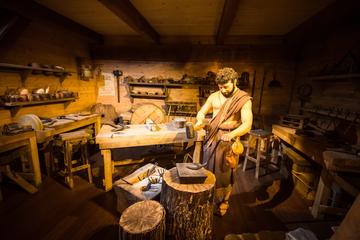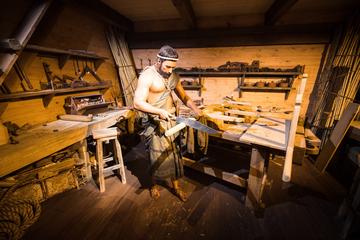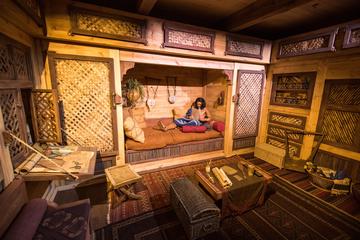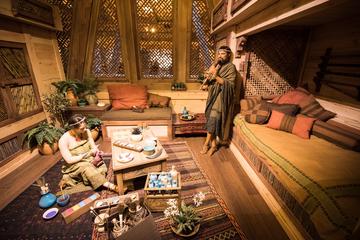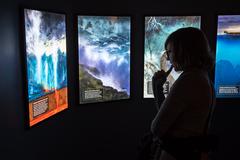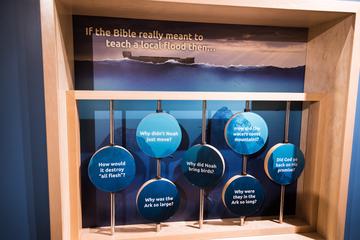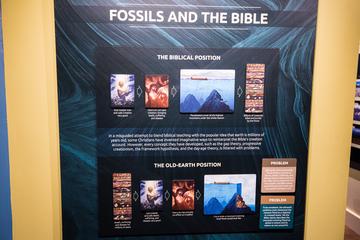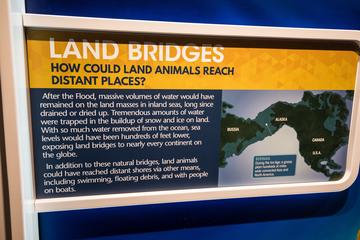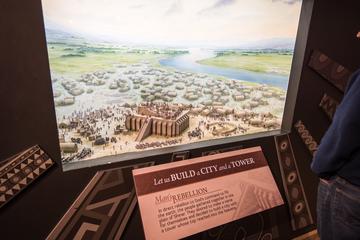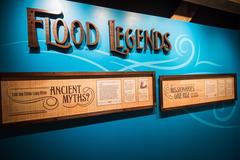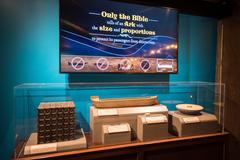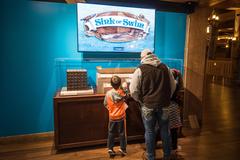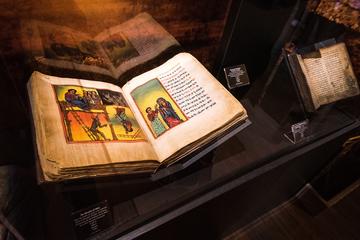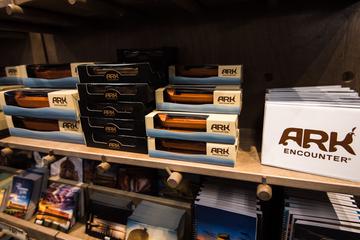Ark Encounter
“Jesus Christ!” I exclaimed as I stepped off the bus into the ice-cold wind. I immediately regretted my blasphemy, given the company I was in, but no one seemed to notice. They had the November wind to deal with, too.
Towering in the distance—too far, given the wind—was a ship. Yes, we were in the middle of a field in Kentucky, miles from navigable water, but before us was a 510-foot-long, 51-foot-high ship—a life-size replica of Noah’s Ark.
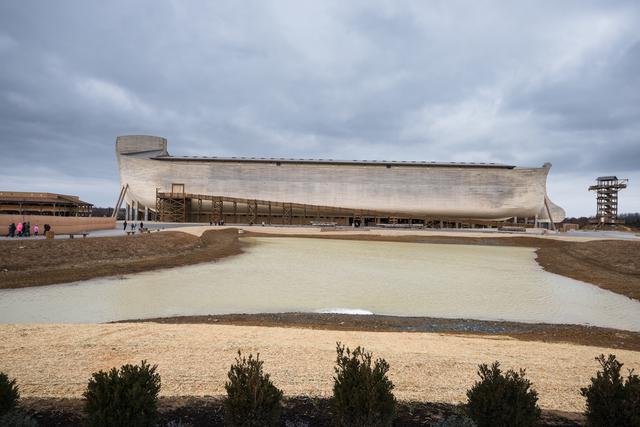
Answers in Genesis (AiG), the folks who brought us the Creation Museum, spent more than a hundred million dollars to build Noah’s Ark next to an Interstate highway in Kentucky, to prove that the Biblical Flood story is plausible. Like the Creation Museum (which I visited several years ago), it’s preaching the idea that every word of the Bible is literally true. In 2348 B.C., when Noah was six hundred years old, God killed everyone, except eight very special people.
Much of the controversy surrounding the Ark Encounter revolves around its public funding. The project received various tax incentives and other support from state and local government—including buying a hundred acres of land from the county for one dollar. Public funding is a problem because AiG requires all Ark employees to sign a statement of faith, affirming that they are not gay and that they believe in the particular brand of extremist Christianity the Ark preaches. AiG won a court case allowing them to keep that requirement.
In addition, all employees are subject to an extra 2% tax on their wages, which goes to pay off AiG’s government loan. That’s right: they make their employees pay their debts.
I’m not here to write about the financing controversy, though; that’s been covered extensively elsewhere. I’m also not here to offer a point-by-point rebuttal of the ignorant, absurd claims made in AiG’s displays; others are more qualified to address some of them. I’m just here to experience the spectacle, and show it to you so you don’t have to attend yourself if you’d rather not.
The parking lot is about three-quarters of a mile from the Ark, far enough that you can’t see it yet, and shuttle buses are needed. And, despite being surrounded by seemingly-endless empty land, you have to pay ten dollars to park. The large lot was mostly empty when I arrived, and there was no line for tickets.
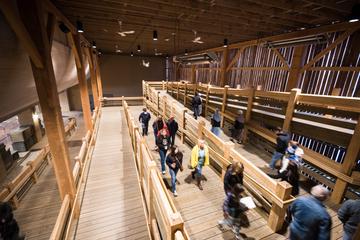
The bus dropped us off a couple hundred yards from the Ark, with a nice pond in between, far enough to get the panoramic view. We walked past booths selling extras—ziplines are a big thing here, but I watched that one episode of South Park, so I know better. I’m not sure what ziplines have to do with Noah’s Ark, anyway. The entrance to the ship was designed to accommodate a long line awaiting entry, but there was no line here, either, despite it being a Saturday.
The ship is impressive, but let’s be honest: it’s a ship-shaped building, built to modern building codes. It’s not seaworthy. The AiG folks remind us that it doesn’t need to be: God double-pinky-swore that wiping out humanity with a global flood was a one-time deal that won’t be repeated, so we don’t need a real Ark. In any case, it’s larger than you’re expecting, which is part of the message AiG is trying to get across: proving that, yes, all those animals will fit.
And that’s the point of this exercise. They already tell the Ark story, in extensive detail, at the Creation Museum, a mere forty-five minutes away, but here, they go well into the weeds, addressing the most minute details of how the Ark could have existed and how it could have supported a pair of every animal for more than a year with only eight human crew. It all starts with some funny math.
Well, no—it all starts with a large room on the lower deck, full of stacks of small crates with watering and feeding devices on the front. This is where the small animals were stored. I walked in and was immediately assaulted by a cacophony of animal howls, hoots, calls, growls, squawks, and so on. Alas, these are mere recordings: the crates are empty, only for show. You may have read that AiG planned to include real animals on the Ark, but that didn’t pan out—mercifully so, for it would be cruel to confine that many animals in these crates just to prove a point. Oh, and it would have smelled.
We also walked past shelves of large clay pots, demonstrating how food was stored. They aren’t real clay; they, too, are just for show.
Then we entered a larger room with animal cages, signs to read, and, for those who haven’t visited the Creation Museum, the first introduction to that funny math.
Funny Math—Animal Kinds
If we want the Ark story to be plausible, we immediately face a major hurdle: math. Two of every animal is a lot of animals. If we take the Bible at its word and accept that Noah didn’t have to go out and gather up all the animals—God sent the animals to Noah, it says—we still have to somehow fit them all onto the boat. Including the dinosaurs.
Oh, yeah—the dinosaurs. There were dinosaurs on the Ark. I was surprised to learn that, when I went to the Creation Museum; I always thought the contention was that the dinosaurs went extinct because they didn’t get tickets to the Ark, but that’s not the case, and it makes perfect sense once AiG explains it: The Bible says that God created man, then created the animals. We know that dinosaurs existed, because we’ve found them buried in the ground. Therefore, dinosaurs existed at the same time as people. The Bible says that two of every animal were on the Ark, not “except the dinosaurs.” Thus, dinosaurs had to be on the Ark. See?
So, we have to fit two of every animal on the Ark, including Tyrannosaurus Rex. How the hell (sorry) does that work? Animal “kinds.”
Two of every kind of bird, of every kind of animal and of every kind of creature that moves along the ground will come to you to be kept alive.
—Genesis 6:20, New International Version
AiG uses a different translation, and I can’t tell which one—their translation of Genesis 6:20 doesn’t match any of the ones at Bible Hub—but the point is in the word “kind”, which appears in almost all translations.
God created some number of animal “kinds.” Within a “kind”, natural selection works, and works quickly: dogs can become wolves, horses can become zebras, and giraffes can develop their long necks where before, their necks were the regular length. But, unlike the theory of evolution, animals of one kind cannot develop into another kind. The created kinds are final, there can never be any more, and if they go extinct, that’s it for that kind.
They even came up with a pseudo-scientific name for this: Baraminology. Let’s be clear: there is no scientific basis for this “kinds” nonsense—it is most definitely not science—but they desperately want you to think it is, they need it to be, because everything else you’re going to see here depends on it.
Remember, the Flood happened a bit more than four thousand years ago—4,363 years, as I type this. According to science, animals 4,363 years ago were basically the same as animals are now. Horses, for example, were horses as we know them. People could ride them around, if they wanted to. It isn’t all that long, geologically speaking. According to AiG, though, that’s not the case. According to AiG, natural selection happens quickly enough that animals now are very different from animals 4,363 years ago—which comes in very handy for their Ark story.
We have to fit two of every animal onto a ship roughly the size of a Ticonderoga class guided-missile cruiser (much smaller than a modern cruise ship), so starting off with a shorter list of animals is helpful.
The result of this funny math is that we only need to fit about 6,700 animals on the Ark. Each of the large cages, with stuffed animals inside, is labeled with the “kind” it represents. Some of these are animals we know and love, and some are now extinct, but most are said to be ancestors of several of what we know as species.
It would also be helpful, if we want to fit all these animals on the boat, if they were smaller than animals are now—and, conveniently, many of AiG’s “kinds” are smaller ancestors of today’s large animals. Horses, for instance, four thousand years ago, in the fervent imagination of AiG, were about the size of a dog today. In the Creation Museum these are called “Ark Equids,” and are an outright fabrication unsupported by any scientific evidence whatsoever. But they fit on the Ark nicely!
Giraffes are a problem, with their freakishly long necks. So, AiG decided giraffes back then had short necks. Just like that!
At this point I know you’re wondering about Tyrannosaurus Rex. The explanation here is more mundane: the Tyrannosaurus representatives on the Ark were juveniles, not fully-grown. Here, a sign explains what the Ark’s carnivores ate during the voyage, exploring several methods of preserving meat.
Now, the apes. They were going to have to deal with the apes at some point. Apes, the story goes, are their own created kind. Humans are most certainly not related to them in any way. And here’s a bit of insanity I bet you’ve never heard, and I’ll quote the display directly so I can’t be accused of misrepresenting AiG’s position here: “Neanderthals were the fully human descendants of Noah.”
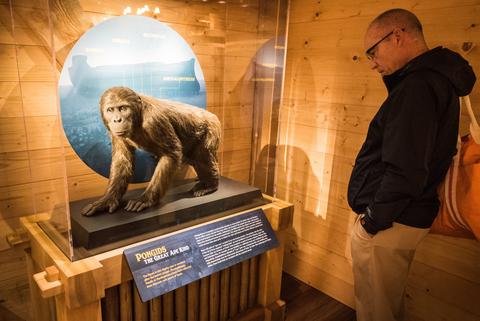
What of all those people—those Christians—who believe evolution is simply how God created everything? That the Genesis story is a simplification, an allegory, and all these animals are indeed God’s creation with evolution as his tool? Well, they’re just wrong, not really Christian, and I guess they’re going to Hell. See, if God had done it that way, that’s what the Bible would say; it doesn’t say that, so it didn’t happen. One of the displays actually includes the statement: “If we cannot believe God concerning how He made the universe, then why should we believe Him about the salvation offered through Jesus Christ?” (The question is not answered.)
I was disappointed with the stuffed animals, because that’s all they were. The Creation Museum has many robotic animal displays, with animals (especially dinosaurs) that move around and are entertaining. Here on the Ark, all we get are static displays. Apart from two moving Noah figures, the displays here are basically static. For more than a hundred million dollars, I was expecting more.
The Pre-Flood World
This exhibit is devoted to explaining why God decided to commit the First Genocide. A series of high-quality illustrations depict people’s descent into wickedness, with their polygamy and their music. Living for pleasure! Pleasure is bad, m’kay?
“Although they deserved to die for their crime,” the display explains, “God showed mercy and provided coverings for them by killing at least one animal in their place.” That’s right: for eating the wrong food, they deserved to die. Those who later perished in the Flood deserved their fate, as well. We all deserve to die, the Ark teaches us, because we are all sinners. Such a fun day out with the kids!
A miniature model shows how much fun the world had become—entirely too fun. It’s never made clear what, exactly, the problem was: “fun is bad” is presented as self-evident.
All that fun had to stop, so God killed everyone except Noah and his sons and their wives, who presumably weren’t having much fun.
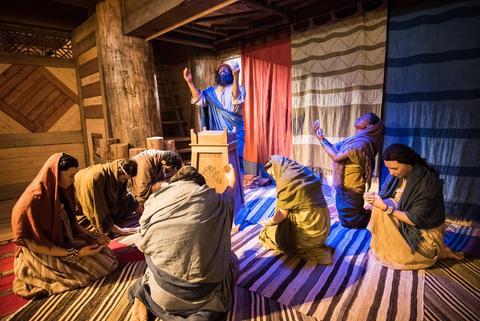
Poop, etc.
Now that we’ve fit all these animals on the boat, we have to take care of them. They need to be fed and watered, the Ark’s interior needs lighting and ventilation, and all that poop has to go somewhere. Think of all the poop!
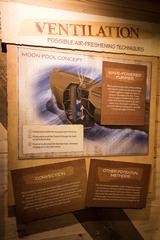
The water supply is easy: rain water collected from the roof fills storage tanks and is distributed via a system of bamboo (or even copper!) pipes.
A moon pool, a water chamber opening through the bottom of the hull, provides ventilation as rising and falling waves pull in air from outside. Lighting is provided by oil lamps, candles, torches, and possibly one or more openings in the Ark’s roof.
Remember the small-animal crates from the first room? Those are equipped with food and water containers that could be refilled every few days. For the large animals, water tanks could be filled via bamboo pipes, and food chutes could be filled from catwalks above with several days worth of food for each cage. Each of the eight human crew would be responsible for more than eight hundred animals each.
Animated videos are provided showing how each of these systems worked.
Now, about the poop. The amount of poop 6,700 animals—including, remember, Tyrannosaurus Rex—generate is just staggering. Keeping the place from stinking unbearably would be a full-time job, no?
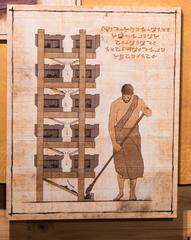
The small-animal crates were equipped with slotted floors. Angled trays beneath each crate funneled the poop into trays at the bottom of each stack, to be cleaned by the overworked crew.
For the large animals, a gutter system beneath the cage floors collected the pee into a central reservoir that could be dumped into the sea. The poop, though, had to be shoveled into wheelbarrows and carted off to a vertical conveyer-belt system powered by one of the larger animals on a treadmill. The conveyer system dumped the poop into a vertical shaft open to the sea below—one of the moon pools.
Noah’s family spent a lot of time dealing with poop—and AiG spent a lot of time thinking about it.
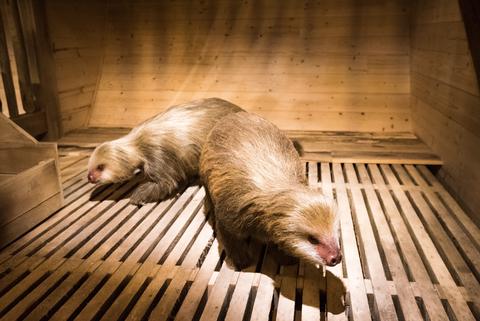
Available on DVD for only $12.99!
In a large room at one end of the ship, a video plays on a loop: The Noah Interview. A hot tabloid reporter (they had tabloids before the Flood, naturally) has come to interview the old man building a giant ship with no sails or oars, miles from any water. She’s made up to look as “bad girl” as possible, with the makeup and the leather and the vaguely Cockney-ish accent, and she’s there to make Noah look like a fool, her hunky, tattooed scribe and illustrator in tow. Noah endures her snotty attitude, silly questions, and hammy overacting, trying to explain that God told him to build a giant ship and is going to kill everyone.
They are interrupted several times by Noah’s hired hands—the guys who are helping build the Ark, but who will, ultimately, be left to drown anyway.
Fairy Tale Ark
At one point on the second deck, I found an attractive room with a sign, “Fairy Tale Ark”. Inside, many children’s books were displayed on shelves. I thought this would be a display about all the nice ways children can be taught the Ark story—but no. This display was about how bad, how evil, how deceptive all the children’s books are.
“Fairy tale ark stories often focus on cute animals and a fun boat ride,” the display tells us. “But the Flood account is about the righteous and holy God judging an exceedingly sinful world with a cataclysmic Flood while showing mercy to Noah’s family and the animals.”
It complains that fairy-tale arks are stylized and don’t resemble the real Ark, while allowing that “stylizing the Ark is not necessarily sinful.” (Emphasis mine.) “Christians should be defending the truth of God’s Word against skeptical attacks rather than providing ammunition to enemies of our Lord.”
Driving home the point that this is not a fun happy story is a sign on the wall: “And everyone died except the 8 people in the Ark.”
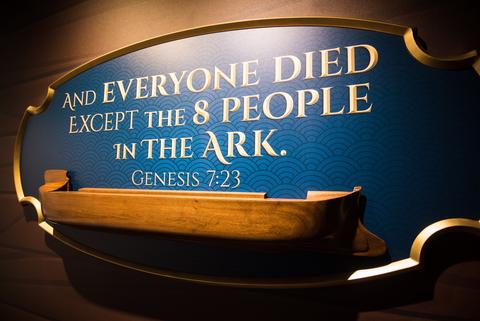
The Man, The Myth, The Legend
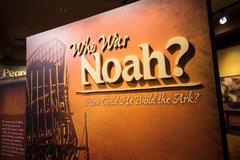
Where the Bible is thin on Noah’s backstory, AiG fills in the gaps, like so many wheelbarrow loads of poop. After working hard on his father’s farm, young Noah traveled to a small port city and became an apprentice shipbuilder and blacksmith. He married the daughter of his employer, and at the young age of five hundred, had the first of his three sons.
(People lived for hundreds of years, back then. The alarming decline in human lifespan post-flood is something AiG largely blames on genetic bottlenecks—like the Flood.)
By the time he had to start building, then, Noah was an expert at working with both wood and metal. With help from his three sons, Shem, Ham, and Japheth, and some hired help he had no intention of saving from the Flood, he built the Ark, a task that took between fifty-five and seventy-five years.
Eight people lived on the Ark for more than a year, and when they weren’t busy shoveling poop, they apparently lived pretty well. The living quarters look like displays in a Bronze Age Ikea, and food was abundant.
The Bible doesn’t give names to the Ark Wives, but AiG does. Noah’s wife was Emzara, a name that comes from the Book of Jubilees, which dates back to perhaps the second century B.C. His daughters-in-law are named in that book, too, but AiG doesn’t use those names: in Jubilees, Shem’s wife was called Sedeqetelebab, which doesn’t exactly roll off the modern tongue, so here, she is Ar’yel, a more child-friendly name.
Ar’yel loves having profound discussions about God, and reads accounts of the world before it descended into wickedness. She writes of her father, who worked with Noah building ships, but who presumably was left to drown with the other sinners.
Ham’s wife, called Ne’elatama’uk in Jubilees, is named Kezia here. Kezia loves dressing up and looking her best (when she’s not shoveling poop) and is the medical expert of the group—a skill she learned from her mother, who also drowned with the other sinners.
Why are the living quarters so nice? We are reminded that God never told Noah how long they would have to live aboard the Ark, so they prepared for a long stay, with a nice home to relax in after long days shoveling dinosaur poop. Indeed, for poop-shovelers stuck on a boat with thousands of animals, these are some clean, nice-looking people, despite the lack of any bathtubs in the otherwise detailed displays.
While the bulk of the Ark diet came from food that could be stored for the long voyage, some vegetables could be grown on the Ark’s upper deck. (All eight crew, like all humans before the Flood, were vegetarians, so there was no temptation to sample the animals.)
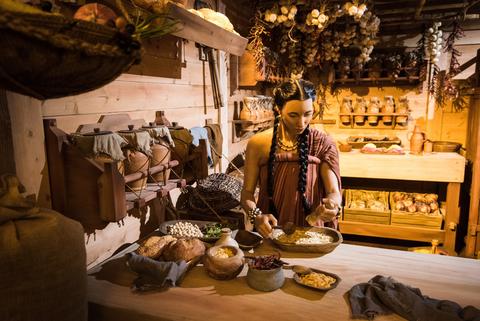
About that Flood
The remainder of the exhibits move away from the minutia of Ark logistics, and are more of a “Creation Museum Lite,” wherein we are treated to an abbreviated version of what the Creation Museum teaches about the Flood. Still, there are some interesting details to be found.
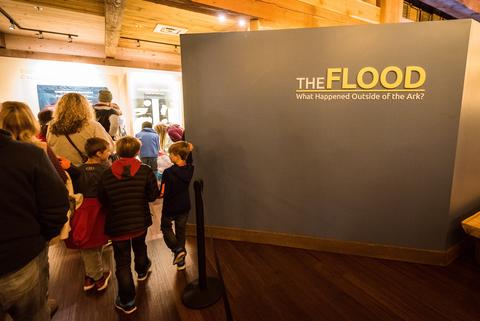
The basic story of the Flood is simple. Everyone was being really bad, so God decided they only had a hundred and twenty years left of that nonsense, and then he would kill them all. At some point, he warned Noah and told him to build the Ark—the best we can pin down is that this warning came between seventy-five and fifty-five years before the Flood.
Before the Flood, three-quarters of the Earth’s surface was land, in the form of a single supercontinent, Pangea. The mountains were smaller and the ocean shallower, and much of the water was underground. The Flood water came not just through rain; the ground opened up, steam vented from below, and water poured forth. The land shattered, the continents broke apart; mountains rose and ocean trenches deepened. The entire surface of the Earth was destroyed and renewed in a violent Flood.
The Ark was built on relatively high ground, so by the time it took to the sea, the mountains were mostly underwater and there were few obstacles for the unpowered vessel. (We cannot know where this happened, since the surface of the Earth is completely different now.)

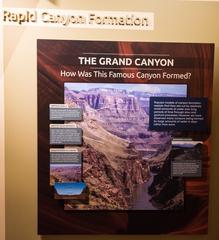
All of the geological layers we now think, in our naïveté, were laid down over millions of years, were in fact created during the Flood. All those dinosaur fossils were laid down at once. The Grand Canyon was carved from rock by the Flood; the argument here is basically “oh, come on, do you really think that big canyon was created by that tiny little river?” The oil we pump from the ground was created from animal and plant matter during the Flood. The continents drifted into their current configuration, starting from a single supercontinent, in a matter of months. And, finally, Noah’s Ark came to rest on Mount Ararat, in modern-day Turkey.
This happened in 2348 B.C.
That’s a problem. The problem for this timeline is that, in 2348 B.C., civilizations already existed that were writing things down and leaving things behind. Perhaps the best illustration of the problem is that the Great Pyramid of Giza in Egypt was built about two hundred years before the Flood. AiG hand-waves this away with the assertion that we simply have the timeline wrong.
Skeptics often claim that the Biblical Flood story is based on a local flood, a major event in the region the story’s authors lived in, but that the authors didn’t grasp the scope of “the world” because, you know, they lived in the Bronze Age and didn’t have Facebook. AiG dedicates an exhibit to debunking the claims of these silly people, which, after all, are easy to debunk: If the Flood was local, why didn’t Noah just move? How did the waters cover mountains? Why did Noah bring birds?
One display depicts what these silly people must believe, if the flood had been local: water covering a mountain, and then just stopping, in mid-air, as if by magic. Obviously that’s just silly, so obviously the Flood had to be global. Also, if the Flood didn’t destroy the entire world, then man’s sin would have virtually no effect on creation, and that would be madness. Basically, the story has to be true because it’s true!
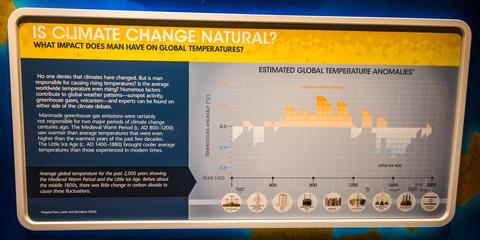
Unhappily Ever After
After the Flood, much water was left trapped in inland seas, leaving ocean levels much lower than they are today. Thus, land bridges between continents allowed animals to migrate across the Earth. People were more reluctant to spread out, so we get the Tower of Babel story.
Basically, while the animals set forth into the world, the people stubbornly refused to leave and just hung around, enjoying the safety and comfort of numbers. When they decided to build a tower to reach the heavens, God became impatient and made them all start speaking different languages so they couldn’t understand each other any more. Finally, people gave up and headed out to different parts of the world, where they struggled just to meet their basic needs.
There was an ice age—just the one, caused by the sudden environmental changes of the Flood. There is no evidence of an ice age four thousand years ago, but since evidence that ice ages happened at some point is overwhelming, AiG needs to shove one into their timeline, and here it is.
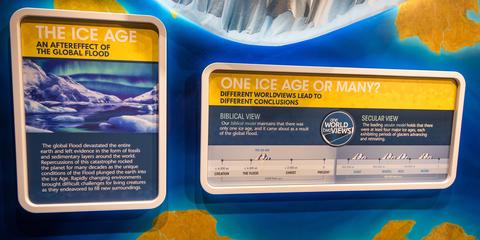
After people spread out across the world, some of them started telling stories about a great flood—but they were just talking smack. Their arks, see, aren’t as good as our Ark. Their stories just don’t make sense like ours does. They’re clearly all wrong.
I mean, just look at these arks! One of them is a cube, for crying out loud! That’s not seaworthy! One of them is barely a raft. One is a tiny little canoe! How the hell (sorry) are all those animals going to fit in a canoe?
Finally, we get a display that has nothing to do with the Ark—a bunch of old Bibles and other manuscripts on display. These are interesting, but it’s not clear why they are here.
Exit through the gift shop
And that’s it. Exit through the gift shop, rife with stuffed animals and toy Arks (all correct; no stylized arks here). Should you want to build your own Ark, a “construction cubit” measuring tool is available so you can get your measurements right.
At this point, as I didn’t want to walk through the Ark again, I exited beneath the Ark’s stern, back into the freezing wind. A restaurant is just outside—Emzara’s Kitchen, named for Noah’s wife. I didn’t go in. Another restaurant is planned but not yet built.
Also planned but not yet built are a Tower of Babel and a replica of a pre-flood village. There is a petting zoo, but I felt a little old for that and skipped it.
I was a little disappointed with the Ark Encounter. Sure, it had the spectacle, but it just wasn’t all that exciting. The Creation Museum’s displays are much better and more entertaining; all we get on the Ark are stuffed animals and illustrations. The only moving displays are two robotic Noahs, one of which just moves up and down praying. The other is an Interactive Noah, where you tap on questions on a touchscreen and the moving Noah answers the pre-selected questions with canned, recorded answers. The Creation Museum has this same display.
The ship itself is impressive, though; I’ll give them that. But while there were a lot of people in attendance, judging from the mostly-empty parking lot and lack of any lines (where there are clear preparations for long lines) I’m guessing it wasn’t as many paying customers as AiG was expecting, when the Ark opened earlier this year. And, well, winter is coming.
